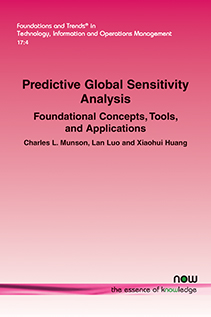Predictive Global Sensitivity Analysis: Foundational Concepts, Tools, and Applications
By Charles L. Munson, Washington State University, USA, munson@wsu.edu | Lan Luo, University of Hartford, USA, lluo@hartford.edu | Xiaohui Huang, Gilead Sciences, USA, huang.email@gmail.com
Abstract
Modern managers must sift through huge data overload to make quick decisions in dynamic environments. Predictive Global Sensitivity Analysis (PGSA) represents a statistical approach to simplifying a complicated mathematical optimization model into a straightforward set of predictive equations by summarizing numerous complexities into a few highly explanatory variables. Managers can use such equations to make swift decisions with colleagues or customers in real time, or the equations can be used as a monitoring tool to verify current decisions as external conditions change.
In this monograph, the authors review the published applications of PGSA that have emerged over the past two decades. Differences in the published works illustrate the underlying flexible nature of the method. Modelers get to practice significant judgement all throughout the process, from application selection through model validation. Section 3 provides a step-by-step tutorial of the full PGSA process. The authors describe how each step has been addressed in the literature to date, and they illustrate each step in detail using two new applications of classic problems in operations research. Section 4 introduces a brand-new application of PGSA that predicts which among three centralized purchasing scenarios that a newly introduced product purchased at a local site should adopt.
Predictive Global Sensitivity Analysis: Foundational Concepts, Tools, and Applications
Predictive Global Sensitivity Analysis: Foundational Concepts, Tools, and Applications provides a detailed tutorial as a guide for both researchers and practitioners to understand how and when to implement PGSA. While the technique involves a fair amount of “number crunching,” it also requires a significant subjective cognitive component. The researcher must consider how to define potential summary variables and subsequently use judgement to determine which to keep and which interaction terms to include. If initial results underperform, the researcher must rethink initial approaches and try again. The tutorial section follows two examples through each step of the process.
The monograph is organized as follows. Section 2 describes the PGSA applications that appear in the literature. Section 3 represents the tutorial section, which describes each step in the process and illustrates how each step is applied to two examples: (1) a safety stock model using the fill rate criterion, and (2) a classic linear programming transportation problem. Section 4 presents a full PGSA application for a model used by firms with multiple facilities purchasing many different component parts. The model determines which parts should be purchased locally, which should be purchased centrally, and which should be partially centralized. The PGSA predictive equations do an excellent job at placing parts into the three categories. Section 5 concludes by describing the challenges and limitations of PGSA, along with providing several recommendations for future research.
